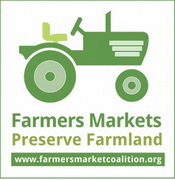Farmers Markets Preserve Farmland and Rural Livelihoods
 Farmers Markets Preserve Farmland and Rural Livelihoods
Farmers Markets Preserve Farmland and Rural Livelihoods
What comes to mind when you think about a farmer? For many Americans, farmers exemplify the fundamental essence of our nation’s core values. Entrepreneurship. Industry. Self-sufficiency. Innovation. It’s difficult to understand how anyone who possesses these qualities could find themselves struggling to sustain their livelihood – especially when that livelihood produces what everyone in this country needs everyday: food.
Yet according to the USDA, from 1992 to 2007, 21% of mid-sized farms in the U.S. have seen the fruit of their labor fail and go out of business. In this challenging climate dominated by large corporations, small farmers – most notably young and new farmers – are doing everything they can to maintain a thriving business and keep their livelihood from going belly-up. A 2012 USDA agriculture census illuminated a sobering statistic about the future of farming: there are almost 4 times as many U.S. farmers are over the age of 65 as there are under the age of 35.
However, for the young, new and experienced farmers alike, there is a rapidly growing light at the end of the tunnel in the form of farmers markets. Over the past decade, the increasing demand for fresh, local food has sparked the exponential growth of farmers markets nationwide, while serendipitously expanding the opportunity for small farming enterprises to enter the market, take root and grow. Farmers markets are proving to be the ideal venue for new and young entrepreneurs to cultivate a small, burgeoning business.
So, how are farmers markets supporting small and mid-size farmers?
- Small-scale farmers use farmers markets as incubators for new enterprises and gain real-time feedback on new crops and varieties.
- Small and mid-size farmers who sell at farmers markets have nearly a 10 percent greater chance of staying in business than those selling goods through traditional channels. [i]
- Even small community markets are champions of farmland preservation and farm viability; Georgia’s Lilburn Farmers Market gives 10 farmers an opportunity to grow produce on 500 acres of farmland.
- Eighty percent of farmers market vendors in Iowa, New York, and California said that farmers markets offer them a greater opportunity for business development than any other possible marketing outlet. [ii]
- The seven Seattle farmers markets hosted by the Neighborhood Farmers Market Alliance support 9,491 acres of farmland in diversified production.
- There are 3.5 times as many U.S. farmers over the age of 65 as there are under 35. Farmers markets provide one of the only low-barrier entry points for new farmers, allowing them to start small as they learn and test the market. [iii]
- 16% of farmers selling at farmers markets are under 35 and 43% have farmed for less than 10 These rates are twice the national rates for all farmers according to the 2012 Ag Census. [iv]
- 50% of farmers selling at farmers markets derive at least half their revenue from farmers market sales. [v]
- The number of farmers markets operating in winter months has nearly tripled since 2010. The 2,469 markets open in the winter provide an extended opportunity for farmers to do business. [vi],[vii]
